Dear James: I like older styles and décor, especially some decorative metal ceilings. Can I still get the metal materials, and is the project suitable for do-it-yourselfers?—Greg C.
Dear Greg: The decorative metal ceilings consist of separate panels, and they are still available and becoming more popular. The decorative panels are not very heavy, so they are easy to handle and install, and they maintain their beauty forever.





